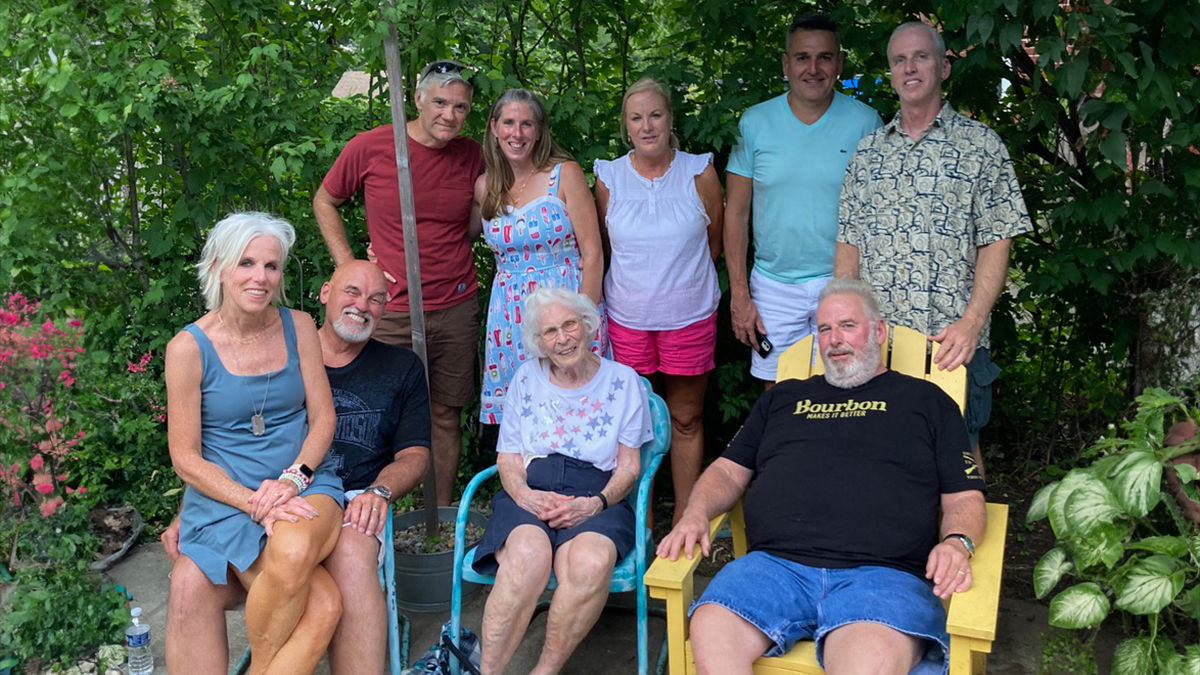Key takeaways:
When writer Judi Ketteler’s mother needed a heart procedure to replace her aortic valve, Judi and her siblings stepped in to help.
Together, the family navigated transcatheter aortic valve replacement (TAVR) — a procedure that replaces the aortic valve in a less invasive way than traditional surgery.
Judi says what she and her family learned from the experience may help others.
In the spring of 2023, my 88-year-old mother’s echocardiogram showed that her aortic valve was narrowing. Called aortic stenosis, this commonly happens with age. “The cardiologist says I need surgery,” my mom said.
I corrected her: “Not surgery, Mom. It’s called TAVR. No big incision or long recovery. You go home the next day.”
TAVR (usually pronounced “tavver”) is short for transcatheter aortic valve replacement. A minimally invasive procedure, it’s a way to replace a failing aortic valve through an artery in your leg.
When my sisters and I went to the follow-up appointment, the cardiologist echoed what I had told my mom about TAVR. “You’re a good candidate,” he said to her.


My mom was initially unconvinced, because she wasn’t yet having a lot of symptoms from the stenosis. Untreated, a faulty aortic valve will eventually lead to heart failure. We had lots of family conversations about TAVR. (I’m one of six living siblings). Together, we read over the material the cardiologist gave her.
“I’m too old,” my mom kept saying.
“That’s the entire point,” I said. “In fact, you might be a little on the young side.”
I showed her a study of TAVR in people 90 and older, and how well they often did. As a journalist who writes about health, I’d been writing about TAVR for years. I knew it was one of the great success stories in cardiology, a feat of medical engineering.
But it turns out that, even when you know more than the average consumer of healthcare, there’s still a learning curve. What we learned in helping our mom may help you and your family.
Read more like this
Explore these related articles, suggested for readers like you.
TAVR: Revolutionizing heart valve replacement
Before TAVR, the only option for replacing a failing aortic valve was open heart surgery. Heart valve surgery is a major procedure, involving a large incision in the chest, and a long recovery. People in their 80s and 90s are too high risk to have the surgery.
TAVR was designed for these older adults. Instead of a large incision in the chest, TAVR requires only a small cut near the groin area. An interventional cardiologist, usually with a heart surgeon also present, performs the procedure.
During the procedure, the doctor attaches the new valve to a catheter, a small, flexible tube that fits through the femoral artery. Then, using imaging, they guide the catheter to the heart, where they inflate the new valve like a balloon.
Your body starts using the new valve right away. You spend the night in the hospital, but usually go home the next day. There are some risks, but far less than with traditional surgery.
Once my mom understood the facts, she was on board. But that part of the journey was just beginning.
Paying attention to aortic stenosis symptoms
The first thing to decide was when my mother should have TAVR. Her echo showed moderate-to-severe stenosis. It wasn’t urgent, but she also shouldn’t put it off forever, the cardiologist said.
In fact, he explained that it’s best if a person finds their “sweet spot” for undergoing TAVR. That means not waiting too long but also not rushing it, especially if they aren’t having many symptoms.
He told my mom to keep a log of any symptoms, and to come back at the end of the year.
Widowed 10 years ago, my mom is of hearty stock and still lives on her own. Though she has slowed down in her late 80s, I would never describe her as lethargic. But by the fall of 2023 — about 4 months after she saw the cardiologist — that’s what she had become.

She didn’t have the motivation to do the things she loved, like cooking, sewing, gardening, and taking walks. Shortness of breath is a hallmark sign of worsening stenosis. But, in my mom, the symptoms looked a little different.
It took my sisters and I really decoding what our mom was saying to understand that her lack of energy was likely because of her stenosis. Once we made the connection, we convinced her to meet with the TAVR team in October 2023.
Getting ready for TAVR and addressing the stroke risk
The first person we met was the TAVR program’s nurse navigator. I’d written about the benefits nurse navigators bring to families. But I had no idea just how helpful it was to work with one.
Our nurse navigator coordinated everything. She made sure my mom had dental clearance. She explained the procedure to us in understandable terms, and told my mom what to expect. She ensured all pre-op appointments were scheduled. And she visited us the morning of the procedure, answering our last-minute questions.
My mom was especially worried about the possibility of having a stroke during the procedure. Pieces of calcium or other debris can break off the old valve during TAVR. Sometimes, they make their way to the brain and cause a stroke.
Her TAVR team suggested the Sentinel device, a type of embolization protection (EP) device. The doctors described it as a “collar” that can catch the debris and prevent it from going to the brain. (They use the wrist artery to place the device during the procedure.) While research hasn’t confirmed that EP devices prevent strokes, my mom opted to use it.
After the procedure, the interventional cardiologist showed us a picture on his phone of what the device caught. Did it prevent a stroke? We can’t know for sure, but we were grateful they offered it to her.
The TAVR procedure and beyond: Restrictions and recovery
The TAVR procedure itself was quick, about 45 minutes. A nurse kept us updated while we were waiting at the hospital, calling my sister every 30 minutes or so.
Within a few hours, our mom was in a private room in the hospital’s cardiac surgery recovery unit. She was alert and hungry. She had to lie (mostly) flat for 4 hours to minimize the risk of bleeding in the femoral artery. By the time we ordered lunch, she could sit up. Soon, we were giggling and telling stories.
My brother brought her home late the next morning, and my siblings and I tag-teamed visiting and staying with her. My mom wasn’t incapacitated by any means, but to minimize the risk of bleeding, she had to follow restrictions about bending over, climbing stairs, and lifting things (nothing heavier than 8 lbs). So it was easier to have someone stay with her the first night.
By her second night at home, she was OK by herself. Within a week, she was driving again. At her 2-week follow-up, her cardiologist cleared her to do more activity, including taking walks and doing housework that involves bending and reaching. She said she never had any pain — not during the procedure, and not afterward.
She recently started cardiac rehab. In addition to helping her get even stronger, it also has a social component. We joke there could be a treadmill romance in her future.
From my writing, I knew that TAVR had a reputation for having a miraculous effect. But while some people report feeling better immediately, especially if they were barely able to breathe before, most take several days to several weeks to see improvement.
For my mom, it’s more that she seems like herself again: independent, capable, and ready for the next challenge.

Why trust our experts?





















